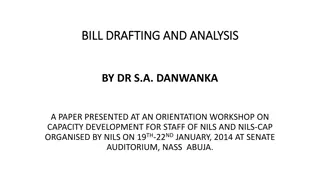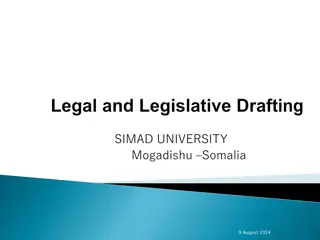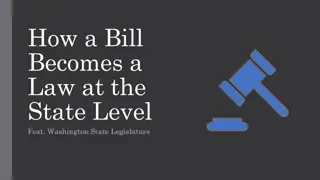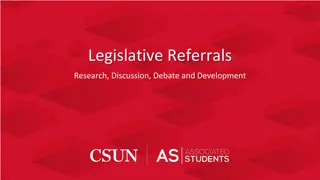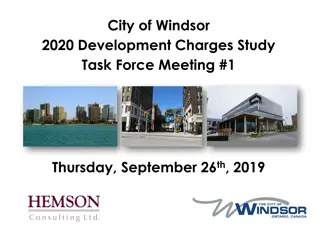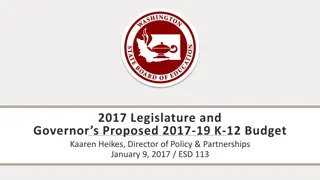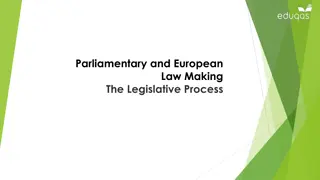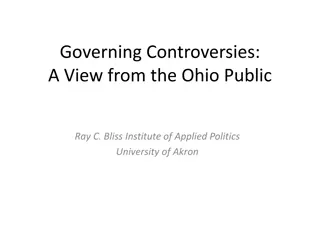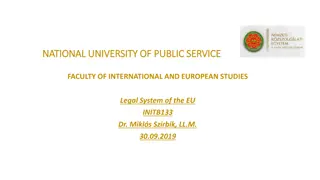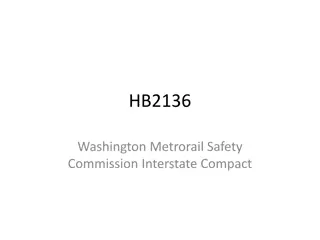Understanding the Legislative Process: How a Bill Becomes Law in a State
The legislative process of how a bill becomes law in a state is elucidated here, covering the roles of the legislature, the law-making process, the definition and importance of bills, and the objectives they aim to achieve. Through this detailed explanation, legislative practitioners gain insight into the dynamics and challenges of lawmaking in contemporary Nigeria.
Download Presentation

Please find below an Image/Link to download the presentation.
The content on the website is provided AS IS for your information and personal use only. It may not be sold, licensed, or shared on other websites without obtaining consent from the author. Download presentation by click this link. If you encounter any issues during the download, it is possible that the publisher has removed the file from their server.
E N D
Presentation Transcript
How a Bill can become Law of a state Presented by Niyi Ajiboye
Objectives of this session To acquaint and / or refresh state legislative practitioners with the process of law making To provide legislative practitioners with the tools for effective law making, particularly at the state level To identify the dynamics / challenges of law making in contemporary Nigeria.
Introduction The primary responsibility of the legislature is to make law. By section 4(6) and (7) of the CFRN1999. It empowers the state legislature to make laws for the peace, order and good governance of the State or any part thereof. The legislature exercises its law making function through legislations process(s) either enshrined in the Constitution and/or Standing Orders/Rules made pursuant thereto. following a systematic
The Law-Making Process Laws are made by the presentation of bills in the House and the assent of the Governor is obtained, except the House overrides the Governor s assent. The power of all House of Assembly to make laws shall be exercised by bills passed by the House of Assembly and, except as otherwise provided by this section, assented by the Governor. Section 100(1) of the CFRN
What then is a bill? A bill has been defined as a draft for a proposal of a law of the Legislative Assembly with a view to its being passed into law (see the Supreme Court per Obaseki JSC in Attorney-General of Bendel State v. Attorney- General of the Federation (Volume 1, Legislative Law Report of Nigeria 1962-2001) at page 10. the draft of a proposed law - The New International Webster s Comprehensive Dictionary of the English the draft of a proposed law to be discussed in parliament - the Oxford Advanced Learners Dictionary
Definition of a bill cont From the above definitions, a bill is essentially: A proposed legislation Must be in a draft form Is ready to be presented or indeed presented before the legislative assembly which is constitutionally empowered to make laws. The bill is not the document on which the draft is contained; the draft itself is the bill (AG Bendel v. AGF supra).
The objects of a bill A bill may be enacted into law to do any of the following: Establish a government agency or department; Amend an existing law; Consolidate existing enactments with similar intents; Validating an act already carried out if public interest demands To enact Subsidiary Legislations (e.g House Rules of procedure)
Objects of a bill cont The primary object of any piece of legislation is to address basic issues that affect the lives of the people so that the conduct of government and its citizens are regulated to avoid anarchy. It is by means of legislations that state administrations in Nigeria implement party programs, react to the needs for basic changes in economic, social and political structure in the state The legislative proposal may emanate from a variety of sources Executive, legislature, interest groups, etc.
Sources of Bills A bill may originate from a variety of sources: From the Executive From Members of parliament From the Judiciary Interest / professional Groups Private persons
Executive Bill Over the years, the Executive has been a primary source of legislative proposals for the following reasons: They dominate policy making They have acquired strong technical capacity over time They have more access to government information They have enjoyed more institutional stability
Members Bills Law making is the primary duty of the legislature. Often times legislators propose bills for the following reasons: To fulfill their electoral promises To promote personal legislative agenda. To promote constituent interests and needs To correct a defect in existing law or to address an emerging state issue.
The Judiciary A Bill may also originate from the Judiciary through the Chief Judge of the State. A bill originating from the judiciary, though not called an executive bill, it is nonetheless regarded as Government Bill
Private Bills A Private Bill is Member Bill. Interest groups such as professional bodies, trade unions and other pressure groups constitute a major source of legislative proposals. Interest groups may wish to have legislative support for their group interest. To do this, they articulate their proposals and present same to a legislator to introduce the Bill on the floor on their behalf. An individual may also propose a bill and forward same to a legislator for presentation. any bill other than Executive or a
Drafting a Bill After the sponsor of a Bill has articulated his proposals detailing the policy framework of the Bill, what the proposed bill seeks to achieve and the mechanism to enforce the law if passed, he then transmits the proposals to the Draftsman to put the proposal in a technical form the Bill. usually a lawyer with experience in legislative drafting. The Draftsman is
Preliminary Issues to Consider The sponsors of a Bill must scrutinize the bill to ensure the following: That the bill is not in conflict with constitutional provisions The bill must not propose a law to have retrospective effect when passed; (particularly legislation with penal sanctions); The subject matter of the bill must be one in which the State House of Assembly is competent to legislate on (only matters on the Concurrent Legislative List); The Bill must be one that if passed into law, will not be burdensome on the part of the government to implement; To ascertain whether the idea of a new law on the subject matter is desirable or whether to amend, consolidate or repeal existing law.
Format of a Bill A bill is made up of several component parts. All bills may not have the same or similar substantive provisions because the objects and purpose of the Bills may differ from one to another. However, the arrangement of the component parts established pattern as follows: usually follows an
Long Title: Most enactments usually have Long Titles. The purpose is to highlight the object and intendment of the enactment. It helps to determine the scope of the bill when it is being considered by the House, e.g. A BILL FOR A LAW TO ESTABLISH THE LAGOS STATE AUDIT IMPLEMENTATION COMMITTEE AND FOR OTHER PURPOSES CONNECTED THEREWITH The long title is construed to be part of the Statute and be useful to resolve any ambiguity that may arise from the Main and Ordinary words of a Statute.
Preamble: Is a declaration by the legislature of the reason for the passage of the law. Like the long title, the preamble is construed as part and parcel of the enactment. It is not the case that a law must have the long title and the preamble. inserted if it would be difficult to known the purpose of the law unless and until certain facts (the mischief the law seeks to remedy) are disclosed. They are common under military dispensations. A preamble will be
Enacting Formula This is usually found at the beginning of any legislative enactment. establish the law. It comes immediately after the long title (or preamble) as the case may be), e.g. Be it Enacted by the House of Assembly of Lagos State as follow The purpose is to
Short Title The Short Title is the short name by which the statute is cited and identified. Unlike the long title, it presents a very brief information on the subject matter of the bill. It can come at the beginning or at the end of the law: e.g. This Bill May be Cited as the Lagos State Public Procurement Law (Amendment) Bill 2011 .
Marginal Notes and References: The purpose of the marginal note is to describe the section to which it relates. They are not used to describe the sub-sections or paragraphs. Unlike the long title, the marginal note does not form part of the enactment. Interpretation Act provides that a heading or marginal note does not form part of the enactment and is intended for convenience or reference only . However, court may refer to the marginal note to resolve contentious issues provisions of the enactment are ambiguous. Section 3 (3) of the in cases where the
Interpretation Section: The interpretation Section is called the definition Clause . It contains the definitions or meanings of words and expressions used in the statute. It can come either at the beginning (just after the short title) or towards the end of the statute. As a general rule, where a particular word or expression is not defined in the interpretation section of a statute, the Interpretation Laws of the State will be resorted to for the purpose of construction or interpretation.
Sections and Sub-sections: Statutes are usually divided into sections and sub-sections. It is advisable that a section should contain one main idea which explanatory, short, ambiguity. Where the composition of a section is too long, the proper thing is to divide it into sub- sections. should and be self of lucid devoid
Paragraphs: Paragraphing becomes necessary where a section or sub-section of the statute becomes unduly long. Paragraphing creates clarity and better understanding of the legislative sentence. A paragraph may be broken into sub-paragraphs where the paragraph in the sentence becomes too long. A paragraph is to be numbered with lower case letters of the alphabet in parenthesis thus: (a), (b), (c) in italics, while a sub-paragraph is to be numbered with small roman numerals thus: (i), (ii), (iii) .
House procedure on general bills There are several stages in the consideration of the bill in the House namely: Presentation of the bill First readings Second reading Committal and reporting stage Third reading and passage Governor s assent
Presentation of the bill The first step in the consideration of the bill is the receipt of the proposal from the Governor in the form of a bill (for Executive Bills). The bill is usually forwarded by a covering letter signed by the Governor to the Speaker of the State House of Assembly. The same procedure applied to Bill from the Judiciary except that the forwarding letter is signed by the Chief Judge of the State. On receipt of the Bill, the Presiding Officer sends it to its Rules and Business Committee to schedule it in the agenda for the business of the House, for its First Reading. For Members Bill, a member sponsoring a bill is required to forward the Bill to the Speaker of the House who will in turns send it to the Rules and Business Committee to schedule it for First Reading.
First Reading The First Reading is usually a formality. On the day the Bill is scheduled for First Reading, the Sponsor(s) (in case of Government Bills the Majority Leader, and in case of a member Bill, the Member) moves the motion for the presentation of the Bill for First Reading. The Clerk normally read out the Short Title of the Bill and this constitutes the First Reading. After the First Reading, a convenient day is fixed by the appropriate Committee (Rules and Business) for the Second Reading.
Second Reading The Second Reading is a very important stage in the consideration of the bill. At this stage, the sponsor(s) of the Bill are allowed to lead debates on the general principles of the bill. At the end of the debate, a decision is taken on whether or not the bill should proceed for further consideration. Should the House find merits in the motion in support of the Second Reading, the House would refer the Bill to appropriate Standing Committee(s) of the House for detailed analysis, and consideration of the Bill and to report back their findings to the Whole House.
The Committee Stage At the Committee Stage, the bill is subjected to detailed analysis and amendments can be suggested to the original bill either as to the title of the bill or on any of the clauses of the bill provided the amendment relate to the subject matter of the bill and are intended to give effect to the general purports of the bill. To get to this stage, the Committee may have a need to hold public hearings in order to gauge the views of stakeholders and the general public on the bill being considered. The hearings afford the ordinary citizens opportunities to interact representatives and be involved in the law making process. directly with their
Committee stage cont It is not in every case that a matter is referred to a Standing Committee after the Second Reading. The bill could instead be treated by the Committee of the Whole House if the Standing Orders/Rules of the House so permits (e.g. Rule 81(1) of the Standing Rules of the Senate of Nigeria). Once a bill is committed to the Whole House, the Presiding Officer leaves his seat as Speaker to become the Chairman of the Committee for the purpose of consideration of the Bill. At this point, the Mace is moved down below the table and rested on hock or brackets.
Committee stage cont At the end of work by the Standing Committee, the Chair of the Committee would present the committee s report on a date to be fixed. Members of the House are usually given copies of the Report ahead of time to enable them study and contributions during the consideration. On the day for consideration of the Report, members are free to make comments and suggest further amendments to the Bill. proceedings, the chair shall put the question That I do report the Bill (or the Bill as amended) to the House which question shall be decided without amendment or debate. make comments or At the conclusion of
Third Reading When a Bill has been reported from a Committee of the Whole, it shall be ordered to be read the Third Time forthwith, or upon such day as the Rules and Business Committee may appoint, except a motion for re-committal is carried. At the Third Reading Stage, the Clerk reads out the Long Title of the Bill, although minor amendments may still be entertained, and invariably, the Bill passes the Third Reading.
House Procedure Money Bills A Money Bills can be regarded as bill dealing with government finance and taxation, and for the authorization to spend from the public purse. (e.g finance bills and appropriation bills) For these categories of bills, the procedures are substantially the same with the ordinary bill. The bill has to go through first reading, second reading, and third reading before its passage into law. However, some procedural differences exist
Differences between Ordinary bills and Money bills In the case of Appropriation presentation of the budget to the House by the Governor constitutes the first reading For Appropriation Bills, once the House concludes debates on the general principles of the bill during its second reading, the bill will be referred to the Appropriation Committee for thorough analysis. At this stage, all other standing committees of the House will become sub - committees to the Appropriation Committee. However, for Finance Bills, all other committees do not become sub committees to the Finance Committee. bill, the actual
Enrolment & Governors Assent Once the House has completed action on the bill, a neat copy of the bill (together with all the amendments as carried) is produced and certified by the Clerk of the House. Thereafter he sends the Bill and the attached schedule in duplicate to the Governor for assent.
Governors assent Upon receipt of the passed bill, the Governor could do either of the following: Withholds assent to the bill, and communicate his reasons for withholding assent to the House with a view to getting the house to reconsider the issues raised. The power of the Governor to withhold assent is called Veto Power. Assents the Bill immediately. Once he signs the Bill, the Bill automatically becomes Law of the State and takes effect as from the date it is published in the State Gazette.
override executive veto The Veto Power of the Governor is not absolute. If the Governor refuses to sign any bill into law within thirty (30) days of presentation of the Bill sent to him, the House of Assembly can override his Veto Power by re- passing the Bill into Law by two-third majority and the Bill shall automatically become Law and the assent of the Governor shall not be required (see Section 100(5) of the CFRN). The House cannot re pass the bill by a motion of veto. See National Assembly v The President, FRN Legislative Law Reports of Nigeria Vol 2, at page 897
conclusion Once a bill has been signed into law, the Governor sends the signed law back to the Clerk of the House who shall cause the Government Printer to print out the law in triplicate. The House retains a copy of the Law, delivers a copy to the Governor, and the third copy to the Chief Judge of the state for enrollment as a law of the state.







